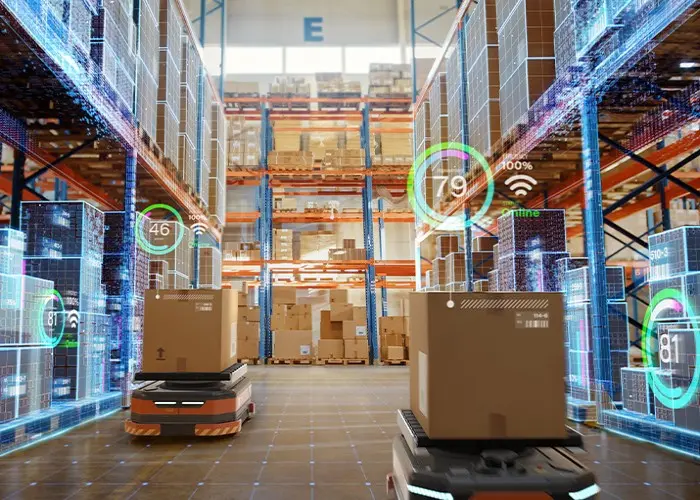- Insights & events
- Blog

Blog | May 6, 2025
Optimizing warehouse savings with warehouse design, automation, and SAP EWM
Hardware- and software-based automation for your warehouse
Whether you have a greenfield, brownfield, or bluefield project ahead of you, warehouse automation continues to increase in importance. There are two different automation approaches that can be taken in warehousing, namely hardware- and software-based approaches.
Two approaches to automation in warehousing
Hardware-based automation involves systems such as conveyors, automated storage and retrieval systems (ASRS), carousels, shuttles, autonomous mobile robots (AMRs), and automated guided vehicles (AGVs), as well as all other warehouse automation technologies that enable, execute, and optimize the physical movements of goods throughout the warehouse. An example of this automation can be the use of AMRs to reduce path distances for activities in the warehouse like picking to staging movements of pallets or the use of a high-throughput ASRS to store and pick goods optimally in the warehouse.
Software-based approaches use algorithms, robotic process automation (RPA) and artificial intelligence (AI) to enable, execute and optimize business processes during the warehouse planning and execution processes. An example of this can be the optimal slotting or relocation of goods in the warehouse triggered by artificial intelligence recognizing a trend in the warehouse data and algorithms determining the relocation movements of the goods to be executed.
SAP EWM supports your individual automation needs
These two types of automation are supported by SAP Extended Warehouse Management (EWM). For hardware-based automation, SAP EWM MFS (Material Flow System) is used to integrate automation into warehouse processes. Coordination of automated movements with manual tasks (for example, forklift movements and pickers) brings efficiency to the warehouse while addressing the significant labor shortage that warehouse operators are facing. Leveraging automation to reduce the distances warehouse workers have to walk during a day’s work increases the time they have for valuable activities.
SAP EWM also supports software-based automation. Algorithms can be used to optimize task management, while robotic process automation (RPA) enables businesses to decrease repetitive tasks in warehouse processes. Additionally, artificial intelligence can be used in SAP EWM to facilitate optimal triggering of activities and recognize potential issues in the warehouse before they become critical. The integration of SAP Joule creates opportunities for warehouse workers to interact with SAP EWM using voice and typed queries. This simplifies tasks such as accessing processes or transactions, aggregating results for easy comprehension, and displaying information for users in intuitive ways. The goal of such software-based automation is to make work easier for warehouse employees, avoid mistakes and ensure reliability while increasing productivity and profitability of your warehouse operations.
An expert automation partner at your side
Both forms of automation require diverse SAP EWM skillsets. With 4flow, you have an SAP expert partner who understands both types of automation integration and the associated complexities.
We provide comprehensive support to our customers:
- Starting from the design of warehouses and distribution centers to ensure optimal layout and efficiency
- Helping clients understand the return on investment (ROI) of warehouse automation by analyzing potential cost savings, productivity gains, and overall operational improvements
- Implementing SAP EWM solutions integrated with advanced warehouse automation technologies, ensuring seamless coordination between automated systems and manual processes
As a partner with SAP Recognized Expertise in Supply Chain in Germany, our SAP experts help businesses manage the complexity of integrating automation into SAP EWM processes.
Let’s talk about how we can help you leverage today’s technology in your SAP EWM environment. As a result, you’ll gain efficiency, reduce the impact of labor shortages and provide your team with an easy way to interact with SAP EWM.
We look forward to helping you optimize your warehouse operations and achieve your business goals.
Contact usOur team is ready to assist you with any questions you may have about our services, including warehouse design, SAP EWM implementation, and automation integration.
Author


Jarrett Leesch
Senior Executive
4flow consulting